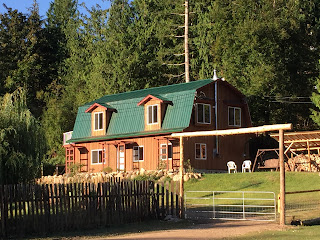Hi. My
name is Annis, and I’m a hope-and-positivity-aholic. But I won’t lie. These
last ten days have thrown me down. Down is foreign to me, as foreign as a speck
in my eye, as foreign as Greek road signs. Down is heavier than a lead suit.
I gave
myself a day to wallow. I sobbed in
disbelief and sorrow. And I took the defeat personally. While out for a walk, I scanned the faces of approaching hikers, wondering whether they had
voted against “me.”
My daughters phoned. They happened to be together in D.C. that week.
“We just wanted to see our mama,” one said.
Then, the three of us sat on Face Time, shaking our heads, moaning our
disappointment, trying to fathom what had just happened.
On Day
Two I started doing the things that usually get me through a crisis. I talked
to Judy about my feelings and fears, spoke with like-minded friends, and wrote in
my journal. I walked, meditated, saw an inspiring movie, surrendered to the
power of poetry. My coping mechanisms started to work. The gloom began to lift
– but, as my mom, Ms. Ruthie, would say, as “slow as molasses in January.”
Donnel
posted a poem by David Whyte on Facebook, “Despair”. A couple of safe Facebook
groups, in which people wrote of their fears and feelings, shared their
stories, and propped each other up with encouragement and validation, sustained
me.
New
friends from the summer writing workshop, Glint of Light, began to share
poetry. Zia, one of our Canadian friends reached out first with a poem by John
O’Donohue, which she offered as a blessing. Its beautiful ending, “May your soul calm, console, and renew you.” And soon more of the group wrote, sharing
the poems of Neruda and Piercy, and telling of their own feelings. Each post became
a soothing balm for my heart.
Time with
my local writing groups, my buddies, buoyed me up with their words and
friendship -- and a bit of wine and cheese and homemade cookies.
And
finally, I am able to write without ranting. Ten days. Ten days passed before I
could sit down and be that hope-and-positivity-aholic again. I sure missed that woman!
As
horrible as these past days have been, I see actions that send me back to
HAPA-land. People are talking. Conversations about the government, the
political system, and the fact we have become complacent and lazy, leaving the
heavy lifting to others. Groups are mobilizing to create change, long-needed
change, at the local and state levels. Our attention has been grabbed. School
boards, city councils, state and US congressional representatives will hear our
words.
Folks
are saying, “I will be bolder. I will stand up for other people. I will be a
safe person for anyone who is harassed or afraid or needs a safe harbor.”
A
small and commonplace thing, the safety pin, has taken on new meaning, has
become a symbol of solidarity, love, sanctuary. A middle school teacher reported
one of her students asked about the safety pin she wore. “It shows I‘m a safe
person and here to help anyone who needs it.”
Her
explanation opened the door for him to tell her he was hungry, his parents
hadn’t filled out the necessary reduced lunch application, and he had no money.
Now, this teacher began to understand him. She had an idea why her student was
behind in his work, didn’t complete assignments. She bought his lunch. Within days,
he appeared with the forms.
Clearly,
the safety pin is not merely – as someone in the blogosphere wrote – “a way for
White people to make themselves feel better.” It’s a signal of solidarity,
compassion, and love for others. It’s a
small thing that can have an impact.
Standing
strong and together, we can make it through these frightening times, through
inevitable upheaval and chaos. Let our enthusiasm reign, our voices be heard,
and our good intentions transform into actions that support and uphold each
other. Commitment. Conversation. Hope. Positivity.
~ xoA ~

















